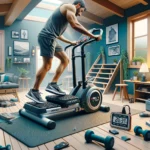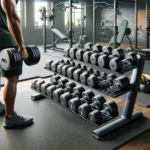What is a power rack, and why do we even need it? This is such a common question so we’ve decided to do a public service by offering the answer right here.
If we’re being honest (and we try to be at all times), we have to admit that the power rack isn’t exactly the most popular workout equipment of them all. That’s because not everyone knows how to use it, and many don’t even really understand why people use it to begin with.
So let’s tackle the most common questions about the power rack—with the answers provided, of course!
What does the power rack look like?
You can go to a gym, and then ask the trainer to lead you to their power rack. Or you can just whip out your trusty smartphone, go online, and see pictures of power racks.Basically, it’s a piece of gym equipment that looks like the frame of an old-fashioned telephone booth.
The power rack has pins that you can adjust to a certain height that’s appropriate for a particular exercise. Also, you have safety catches that keep the weight from going lower than a certain point. This is a safety feature that lets you work out without a spotter. But a spotter with a power rack doesn’t hurt either.
Why do you need a power rack?
Many knowledgeable trainers regard the power rack as one of the most important tools in the gym. In fact, some even consider it the most important piece of gym equipment for strength training. Here’s a look at some of the reasons why a power rack is so useful:
You can train without a spotter.
If you don’t have a power rack, lifting heavy barbells while you’re lying down on a bench isn’t exactly a good idea if you don’t have a spotter. The spotter can help you out when you reach the point where you can’t lift the barbell anymore. The same safety feature is available with the power rack, as it has the adjustable safety catches that keep the weight from falling on you.
You’re more confident, and you get the peace of mind you need when you workout
What this means is that you can try to find out whether or not you can handle 5 or 10 more extra pounds on the bar, without having to worry about what will happen if you can’t handle the extra weight. It also means you can train to failure. For many experienced gym goers, training to failure—doing reps until you can’t do them anymore—is a crucial part of the workout.
You can do a LOT of crucial exercises.
You certainly can do just about all the most important weightlifting exercises that are most effective in making your muscles bigger and boosting your strength.
Just what exercises can you do on a power rack?
This is a very long list, so let’s limit ourselves to the most common ones. Let’s start with the basic weightlifting exercises:
- Squat
- Bench press (along with the “close grip” version)
- Overhead press (along with variations like the barbell seated press and the overhead rack locout)
- Rack pull
- Barbell curl
- Barbell bent over rows
- Inverted rows
- Barbell shrug
- Upright row
Now these days, power racks typically come with the pull up and dip bar attachments. So these enable you to perform variations of the following exercises:
- Pull-ups
- Dips
- Hanging leg raise
- Hanging knee raise
So that’s it? Not quite, and that’s because some models allow for the cable pulley system add-on which allows for more exercises including:
- Lat pull down
- Cable row
- Biceps cable curl
- Cable crunches
Obviously, these lists are in no way complete. But that should show you that this equipment does allow you to do a lot of exercises altogether.
Can you get a squat rack instead of a power rack?
A squat rack is not the same as a power rack, despite what some online articles may say. A squat rack is just a half rack and you use the barbell off the front of it.
If we’re being a wiseass (which we try not to be too often), we can say that yes, you can get a squat rack instead of a power rack (aka the full rack). But that’s not the right question.
The right question is whether or not you should, and the answer is usually no, you shouldn’t. In the matter of the power rack vs squat rack debate, any expert can tell you that the power rack is a much better choice.
- Let’s start with how each one can be useful for you.
You’ll find that the power rack is much more versatile. With the safety catches and adjustable pins, you can do more types of lifts safely,compared to mostly doing squats when you have the squat rack only. And you don’t get the pull-up bar attachment with the squat rack.
- Now let’s talk about safety.
There’s no argument here—even squat rack fans acknowledge that the power rack is safer. That’s mostly because you do your lifts while you’re inside the power rack enclosure. The power rack will catch the barbell, regardless of whether you’re falling forward or backward. On the other hand, even if the squat rack does have the safety arms that can help catch a failed rep, this only works when you fall on the right direction. Also, not all of these squat racks have the safety arms, and even then they’re not supported at both ends like those on the power rack. Squat racks are also lighter than power racks, so they’re unable to catch the barbell as well as the power rack can. In fact, with some squat racks the weight may cause the rack to just tip over.
- Some people say that squat racks don’t need as much space, so they’re better for smaller apartments.
That’s not really entirely accurate.It’s true that the power rack needs a high ceiling of at least 8 feet, while the squat rack doesn’t need that. It’s also true that the squat rack doesn’t occupy as much space in the room. But you’ll still exercise in front of the squat rack anyway. So that means you’re going to need as much space when you use the squat rack. Finally, small apartments may not have strong enough floors that can take the weight when you dump your barbell.
- Finally, there’s the matter of cost.
On the face of it, it’s true that the power rack is more expensive. But the problem with the squat rack is usually about the need to dump the barbell when you can’t lift anymore. Either you’ll have to buy solid rubber padding to protect your floor (which can be expensive) or you’ll have to fix your floor when it gets damaged, which is even more expensive.
What about the Smith machine?
The Smith machine seems to work like the power rack, as it also stops the bar when it becomes too heavy for you. But that’s as far as it goes—in the matter of the power rack vs Smith machine, the Smith machine sucks.
We aren’t the only ones to say so.
- Men’s Fitness calls it one of the gym machines you should never use.
- Bodybuilding.com calls it “one of the biggest mistakes in strength training equipment”.
- Stronglifts.com lists down 10 reasons why it “sucks”.
The problem with it is two-fold:
- It balances the weight for you. This lessens the tension in your muscles, which in turn lessens the gains you can achieve.
- The bar in the Smith also moves in a fixed path. This coerces your elbows and shoulders into unnatural positions that can minimize your gains, and this can also lead to injury.
Wrap-Up!
Hopefully we’ve answered most of your basic questions about what is a power rack. It’s all about workout effectiveness and workout safety—you get both from the power rack, but not quite from the squat rack or the Smith machine.
If you are interested to find out more about power racks, check out our detailed power rack reviews and recommendations here.

